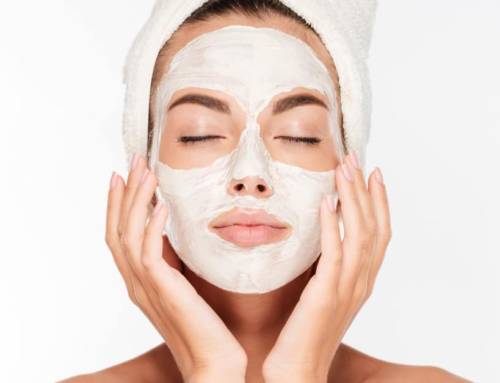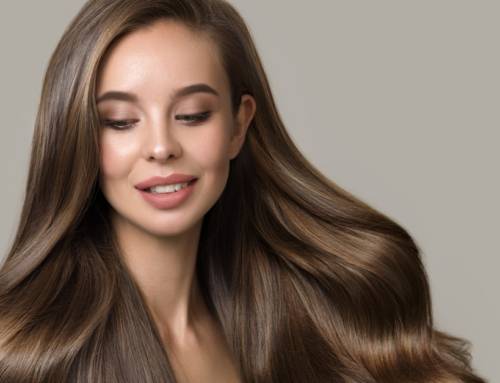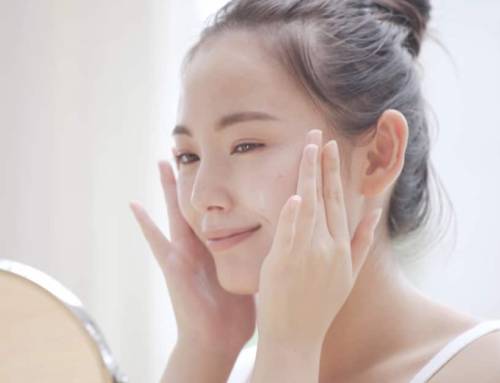Effects of Glycolic Acid on Human Hair Keratin
• Christian Allan, Jeffrey Weeks – CrossChem, US
• Florence Olechowski, Sabilla Digel PhD – Berg + Schmidt, Germany
Glycolic acid is a well-known active ingredient in skin care products. The a– hydroxy acid exfoliates skin by reacting with the upper layer of the epidermis, the strateum corneum, and weakening the lipid bonds that hold the outer dead skin cells together. Subsequently, this allows the outer layers to be removed exposing healthier, living skin cells. This mechanism of action for glycolic acid in skin care has been extensively studied and documented.
In recent years, however, glycolic acid has also begun to attract attention for its potential use in hair care products.
Qualitative testing has shown that a number of physical aspects of human hair are improved through treatment with glycolic acid formulations. Specifically, testing has shown that when compared with untreated human hair, hair samples treated with glycolic acid demonstrated:
- Decreased elastic modulus and greater flexibility
- Increased denaturation temperature leading to healthier hair in a variety of environments
- Greater lubricity leading to healthier- looking, easier-to-manage hair
While such results signal an exciting new option in the world of hair care, exploration of such new possibilities is hampered by the fact that the mechanism by which glycolic acid improves hair health is not well-understood. Though many tests have reported on the results of glycolic acid testing on hair, few have explained the chemical and biological mechanisms which underlie the broad abilities of glycolic acid.
In this article, a review of past and present research is conducted in order to develop a comprehensive explanation for the interactions between glycolic acid and human hair and the results of such interactions. In particular, attention will be given to α-keratin, the primary component in human hair, and its potential interactions with glycolic acid and other α-hydroxy acids.
Decreased elastic modulus
The science
Over 90% of the dry weight of hair comprises keratins, which have a high disulfide bond (S-S) content, derived from the amino acid cysteine. These bonds impart stability to keratin structures.1 The basic macromolecules that form keratin are polypeptide chains that are wound into a “coiled coil”.4 In keratin, two polypeptide chains (a-keratin) twist together to form this coiled coil (Fig 1). The ability of these structures to unwind, even breaking internal H-bonds, is what allows a-helical structures to stretch. Normally, shape is restored when the tension is released and the H-bondsthen reform.2 When internal hair disulfide bonds are damaged or broken, however, the characteristic flexibility of hair strands is lost and hair can become brittle, snarled, and frayed.
In Glycolic Acid No Longer Just For Skin – Changing the Internal Properties of Hair, Evans et al. discuss “how treatment with glycolic acid significantly decreased the Young’s modulus of hair.” Additionally, the report discusses how: “this behavior could be reversed by dialyzing the hair in deionized water (data not shown)”. This indicates that “treatment with glycolic acid did not permanently alter the hair structure, but instead likely induced temporary plasticisation, i.e., softening”.5 As seen in the study Cosmetic and dermatologic use of alpha hydroxy acids, the use of a– hydroxy acids as a plasticiser in cosmetic applications is well documented. As opposed to water, glycolic acid is non- volatile, and “presents a means of manipulating the stiffness of hair in a semi- permanent manner”.3 In the study Effects of chemical structures of polycarboxylic acids on molecular and performance manipulation of hair keratin by Song et al., acids containing carboxyl groups, such as the a-hydroxy acids, are shown to “Crosslinking … could build bonds between the carboxyl groups in the [acids] and the amine groups, sulfhydryl groups and hydroxyl groups in the hair keratin, and thus help hair partially regain intermolecular force and restore its mechanical properties”.7 In this study, it is demonstrated that the addition of carboxylic acids, such as the a-hydroxy acids, into keratin structures can help crosslink neighbouring keratin molecules and repair broken disulfide and hydrogen bonds.
The presence of glycolic acid, a small, highly permeable α-hydroxy acid containing a carboxyl group as well as a hydroxyl group, is perfectly suited to rebuild stability in damaged hair, whether the hair was damaged naturally or through cosmetic treatments such as perms.
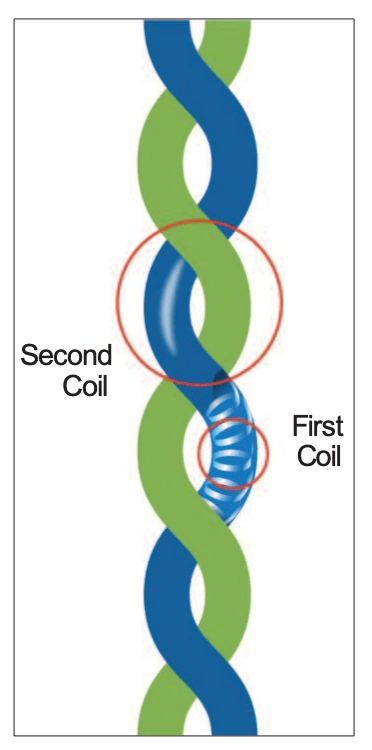
Figure 1: Coiled coil of 2 α-helices.
According to Song, “The perming process usually has two steps: reduction and oxidation. In the first step, disulfide bonds are broken using a reductant”.7 In his study, Evans describes how following many cosmetic chemical hair treatments, “dry- state stiffness, i.e., Young’s modulus, often increases significantly”.5 The small molecular size of glycolic acid, as well as its chemical architecture, make it an ideal addition to effectively repair the broken keratin hydrogen bonds that lead to brittle hair by penetrating deep into hair strands and instigating subsequent crosslink repair. As discussed in Glycolic Acid No Longer Just For Skin – Changing the Internal Properties of Hair, “treatment with glycolic acid significantly decreased the Young’s modulus of hair,” restoring natural hair elasticity, flexibility, and health.5
In application
In practice, the decrease of the elastic modulus in human hair keratin through the application of glycolic acid can be demonstrated empirically. In Glycolic Acid No Longer Just For Skin – Changing the Internal Properties of Hair, virgin Caucasian hair samples were treated with a 5% glycolic acid solution. In this test, both glycolic-acid treated and untreated hair samples were tested to generate stress- strain relations.5 Experimental data yielded mean average Elastic Modulus values for both treated and untreated hair. Test results indicated that treatment with glycolic acid resulted in a decreased the Elastic (Young’s) Modulus of hair samples when all other conditions were held constant. Data for this test can be found in Reference 5. This test identifies a quantifiable relationship between increased glycolic acid content in a hair sample and improved tensile properties of hair strands. These tensile property experiments demonstrate that introduction of glycolic acid in hair care treatments can lead to healthier and more resilient hair, even in cases of quotidian damage.

Figure 2: Tensile strength initial modulus (gf/den). Data from Reference 8.
Further tests conducted by Stasko and recorded in Determining the Effect of Using Glycolic Acid in Hair Care Products illustrate that the restorative and maintenance effects of glycolic acid on hair tensile and material properties extend to a variety of hair types and varying types of hair damage (Fig 2). In a tensile strength experiment conducted on both bleached and unbleached hair samples, glycolic acid-treated samples demonstrated improved tensile properties compared to both water/stearyl-alcohol controls and hair strands treated with a variety of other hair product components.8 Numerical data for this experiment series can be found in Reference 8 which demonstrates improvement of the physical properties of hair with glycolic acid treatment. As mentioned in Reference 3 prior testing has detailed the plasticisation of human skin samples by α-hydroxy acids. In the relevant physical and tensile property experiments conducted in References 5 and 8, the effect of crosslinkage plasticisation elucidated in skin care contexts is thus verified for human hair keratin.
Increased denaturation temperature (TD)
The science
Denaturation is the process by which natural bonds in the native forms of proteins are broken down under any number of conditions. Denaturation temperature is the temperature at which internal protein bonds begin to extensively break down for a specific protein species. From Wortmann, “denaturation is not a homogeneous process, but takes place in specific sets of cells within the cortex of keratin fibers.” Denaturation in human hair is a process that predominantly affects the cortex of hairs. TD (denaturation temperature) decreases significantly with increasing water content, where water is an active plasticiser of the keratin matrix, as discussed in the elastic modulus study. This supports the theory that denaturation with temperature is kinetically controlled by chemical characteristics of the keratin matrix.4
Glycolic acid, as opposed to water, serves as a non-volatile hydrogen-bonding plasticiser as discussed by Evans. In Studies on Keratin, the authors write that “lateral links between parallel polypeptide chains, the bond of the disulfide group of cystine, and the polar link of diamino and dicarboxylic acids” are key in the stability of keratin structures.6 These are the same structural bonds that are discussed in the above section detailing variable elastic moduli for alpha keratin. This study also notes that “Once these two types of bridges have been broken by chemical attack, the keratins behave in their solubility and digestibility by proteolytic enzymes as denatured proteins”.6 In essence, the loss of mechanical effectiveness in keratin structures is linked to the strength of these disulfide and carboxylic links (Fig 3). From Effects of chemical structures of polycarboxylic acids on molecular and performance manipulation of hair keratin by Song, it can be seen that in the case of natural hair, the increasing presence of water as a volatile plasticiser in hair leads to hair frailty. In Evans’ study, an experiment was performed that shows “the tendency for hair breakage is dramatically increased at high humidity”.5 This is indicative of the properties of glycolic acid bonding. By filling spaces in the keratin matrix, glycolic acid both imparts greater stability to the structure while at the same time reducing the amount of water that can successfully bond to the structure of the hair cortex.

Figure 3: Glycolic acid interacts with broken bonds and helps repair crosslinks between α-keratin cross slices.
It can thus be seen that the same chemical mechanisms underlie both increased TD and decreased elastic modulus for hair keratin. In both cases, the ability of glycolic acid to bond into keratin matrix networks showed that “provided the hair fibers with new covalent crosslinking bonds, which could enhance the crosslinking network in the hair fibers, and thus, restrain the swelling and water uptake of the hair fibers”.7 This suggests the reduction of water content accompanied by the repair of molecular bonds by glycolic acid creates a more stably-conformed keratin matrix less vulnerable to volatile plasticisation, and subsequently leads to an increased TD for glycolic acid-treated hair.
In application
Modification of human hair TD through glycolic acid treatment has been analysed through a number of controlled experimental procedures. In a Dynamic Vapor Sorption (DVS) experiment conducted by Evans, the vapour concentration surrounding a sample was varied and the change in mass that was produced was measured. In the controlled DVS experiment, it was shown that “treatment with glycolic acid produced a significant reduction in the water content of hair” when compared to untreated hair.5 Within this procedure, glycolic acid-treated hair as well as untreated hair were equilibrated at various humidities and their adsorption percentage was measured. As outlined in Reference 5, hair treated with glycolic acid showed a greater resistance to water adsorption as opposed to baseline.
In further testing by Evans in Glycolic Acid No Longer Just For Skin – Changing the Internal Properties of Hair, a Differential scanning calorimetry (DSC) test as outlined by Wortmann was performed in order to determine the TD of healthy hair, where a hair sample is heated at a prescribed rate and deviations from a baseline are indicative of enthalpic events.4 The DSC procedure conducted by Evans yielded a TD for healthy hair of approximately 155 ˚C, where treatment with glycolic acid consistently generated increased TD approximately equivalent to a 10 ˚C shift.5 Further DSC measurements conducted in 8 extended the scope of the test to both damaged and undamaged hair samples. In both cases, increases in the TD were observed following the addition of glycolic acid solutions to the hair tresses. In 8, a ~6.5 ˚C increase in TD was noted for treated healthy hair samples (Fig 4), while damaged (bleached) samples treated with glycolic acid demonstrated a ~2.5 ˚C increase in TD. For specific DSC data, refer to References 5 and 8. Taken together, however, the DVS and DSC tests provide a correspondence relationship between the water content in hair strands and TD, where hair samples treated with glycolic acid demonstrated a greater resistance to water adsorption and a subsequent increase in denaturation temperature.

Figure 4: Mean denaturation Temp (°C). Differential scanning calorimetry. Healthy hair. Data from Reference 8.
Increased lubricity
The science
Unlike the properties of elasticity and denaturation temperature, which largely are affected by the cortex of a hair strand, lubricity is largely the result of physical properties affecting the outer ‘cuticle’ of a strand of hair (Fig 5). The cuticle iscsomposed of keratinised scale cells that surround and protect the hair cortex, overlapping much like shingle roofing. In practice, the scaled, or shingle-like structure of the cuticle leads to a lack of hair lubricity when, according to Here’s The Chemistry Behind a Bad Hair Day… Or a Great One the cuticle layers “don’t lay flat, when each strand of hair rubs the strand adjacent to it, these cuticles ‘catch’ and rub together, creating tangles or static electricity”.10 The article also details how “When the shingles don’t lay flat, moisture from air humidity can also seep into the hair. When this happens, a strand of hair swells, but only in spots, not along its entire length. When certain spots swell, but others don’t, the result is ‘kinks’ in the strand”.10 As discussed by Song, the ability of carboxylic acids to quickly and effectively facilitate linkages between keratin molecules imparts uniformity and stability to large keratinised structures.7

Figure 5: A cross-sectional view of the hair strand shows the internal structure including the shaft cuticle and the coiled coil cortex.
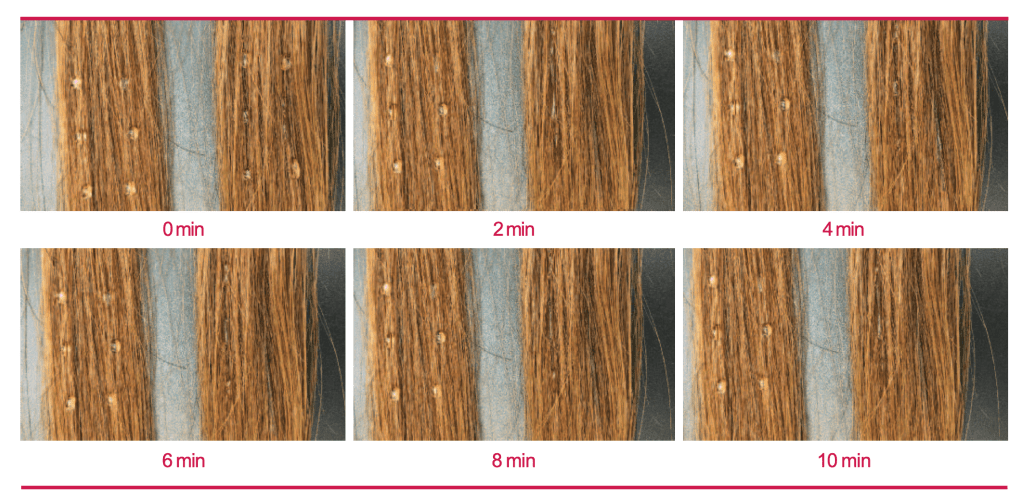
Figure 6: Absorption of water droplets into hair. Left: hair treated with 7% glycolic acid solution; right: hair treated with 7% citric acid solution.
When taken in conjunction with the study by Evans, where “consumers overwhelmingly prefer the feel and properties of hair that is equilibrated at low humidity, i.e., that possesses low water content,” it can be seen that disarray of the hair cuticle layer can lead to greatly increased friction and snagging of hair, as the uniformly straight nature of hair strands is disrupted by unevenly bonded cuticle keratin molecules.5 In addition experiments performed by Berg + Schmidt, damaged hair samples were concurrently subjected to two solutions (7% citric acid & 7% glycolic acid solution at the same pH of 3.8 for one hour), washed with clear water, and dried. In this test, it took longer for moisture to be absorbed into the glycolic acid-treated hair sample as opposed to the citric acid- treated sample, with water droplets remaining on the surface of the hair for a longer time span (Fig 6).11 The significantly longer time required for water to be fully absorbed by the glycolic-acid-treated hair, indicates the straightening and smoothing of the cuticle’s shingle structure, and results in a more hydrophobic ordered, and healthy hair strand on a microscopic scale. This in turn leads to an improved appearance of hair on a macroscopic level.
In comparison to the straightening treatments addressed above, glycolic acid formulations allow the problem of hair lubricity to be addressed more holistically, through the repair of disordered keratins on a molecular scale. Research by Goddard and Michaelis has shown that while disulfide bonds are a key to keratin stability, flexible hydrogen bonding and cross-chain linkage in a-keratin structures give healthy hair its molecular order and characteristic versatility.6 Experiments in Effects of chemical structures of polycarboxylic acids on molecular and performance manipulation of hair keratin show carboxylic acids such as glycolic acid to be effective in strengthening and maintaining polymeric chemical linkages in keratin. The carboxyl functional groups found in this class of acids is known to form covalent linkages with the amine groups found on cysteine and the other amino acids that comprise keratin. Thus, it is clear that glycolic acid increaseshuman hair lubricity through reordering and rebinding the keratin scales of the hair shaft cuticle, so that covalently-bonded intermolecular forces between neighbouring keratin molecules in the α-keratin coils are regained.7 Such repairs will not only increase lubricity by ordering the cuticle, but it also is effective through preventing penetration of the hair strand by foreign molecules and does not simply rely on mechanical straightening to reduce hair entanglement.
In application
Qualitatively, braiding tests performed by Berg + Schmidt demonstrate the increased lubricity and overall hair aesthetics from glycolic acid-supported hair repair. Hair samples treated both with and without glycolic acid were braided in order to bend the hair strands and induce breakages typical of everyday wear and tear.
Following braiding and unbraiding, glycolic acid-treated hair demonstrated a greater capacity for smoothness, ease of management, and return to a natural state, suggesting breakage repair.11 Additionally, a brushing experiment (Fig 7) performed by Stasko in Determining the Effect of Using Glycolic Acid in Hair Care Products, quantified the amount of hair fibres broken by repeated brushing of a hair sample. In hair samples treated with a glycolic acid hair care product, the total amount of broken hair strands at the conclusion of the experiment was less than those untreated samples as well as samples treated with glycolic acid-free hair conditioner products.8
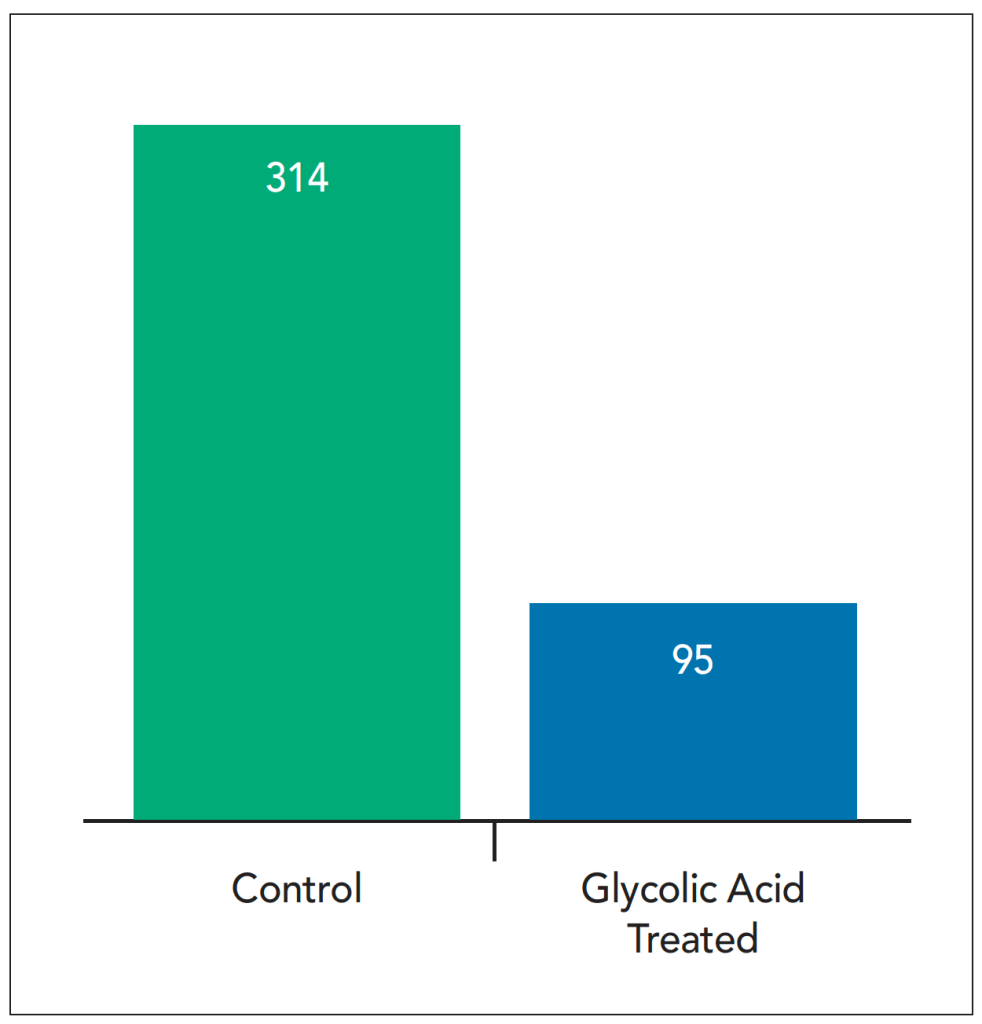
Figure 7: Repeated brushing broken fibres. After 1,000 brushes. Data from Reference 8.
Additional tests performed by Berg + Schmidt confirm the enhanced lubricity of treated hair, where bleached hair tresses treated with a conditioner containing glycolic acid were tested alongside tresses treated with glycolic acid-free conditioner. In measurements of combing force for both hair tresses, samples treated with glycolic acid conditioners demonstrated a marked difference, where less force was required to pass a comb through the hair sample.
Indicative of increased lubricity, this test supports the efficacy of glycolic acid products in the reordering of the hair cuticle following treatment of hair with harsh bleaching products or hair styling compounds.11 As a relevant factor in the improvement of hair lubricity, hair shine was tested by Berg + Schmidt for both treated and untreated samples. As discussed above, decreased lubricity in the hair strand is a result disorder in the cuticle layer of the hair shaft.10 Such disorder will lead to duller hair as the disordered cuticle haphazardly reflects light, leading to a muted, less vibrant appearance. Following treatment with glycolic acid, hair samples demonstrated increased reflective shine as measured by light intensity when compared with untreated or pre-treatment samples.11
Conclusion
In this review, an explanation of the chemical and mechanical effects of glycolic acid on human hair keratin has been formulated through an analysis of available research. Glycolic acid, well-known for its anti-aging characteristics, has been used in the personal care industries for many years as an ingredient in skin care products. Until now, however, results from experiments have largely failed to deliver a comprehensive explanation for the benefits glycolic acid seen in hair care.
This study has shown that interactions on a microscopic level between human hair keratin and glycolic acid is key to understanding the health benefits of glycolic acid hair treatments. In particular, the polymeric nature of human hair keratin formed into a-helical structures gives rise to molecular geometry well-suited to beneficial chemical interactions with glycolic acid. Studies on the characteristics of human hair keratin have demonstrated that linkages across and between proximally-located keratin strands within a– keratin imparts stability and flexibility to healthy human hair. This nature of keratin also gives rise to brittleness, dullness, and general hair unhealthiness when crosslinkages between hair strand keratins become broken and the molecules within the hair strand become separated and disordered.
Glycolic acid’s effectiveness in repairing such breakages is shown to derive from from glycolic acid’s status as a carboxylic acid, as well as its size as the smallest and simplest member of the family of a-hydroxy acids. The molecular structure of glycolic acid includes both carboxyl and hydroxyl functional groups, which are well-suited to bond covalently with the carboxyl and amine groups found in all amino acids, the base-level building blocks of proteins including keratin. Furthermore, glycolic acid’s small size when compared with other α-hydroxy and carboxylic acids allows it to more effectively penetrate hair strands, leading to more effective distribution of glycolic acid compounds throughout the entirety of treated hair.
Overall, it can be seen that the molecular nature of glycolic acid gives it unparalleled effectiveness in the improvement of human hair health. Improvements in hair characteristics such as denaturation temperature, elastic modulus, and lubricity can all be obtained through the use of glycolic acid to repair broken molecular linkages within hair strands as well as prevent penetration of hair by unwanted foreign molecules. The data analysed in this review shows that both healthy and damaged hair can benefit from the addition of glycolic acid to hair care products.
References
- Lancashire Chemistry of Garments: Animal Fibres, The Department of Chemistry, University of the West Indies, Mona Campus, Kingston 7, Jamaica. August 2011. http://wwwchem.uwimona.edu.jm/courses/CH EM2402/Textiles/Animal_Fibres.html
- Mckittrick J, Chen P-Y, Bodde SG, et The Structure, Functions, and Mechanical Properties of Keratin, Department of Mechanical and Aerospace Engineering, UC San Diego. JOM 2012; 64(4): 2012.
- Babilas P, Knie U, Abels C. Cosmetic and dermatologic use of alpha hydroxy Department of Dermatology, Regensburg University Hospital, Franz-Josef-Strauss-Allee Regensburg, Germany. Dr. August Wolff GmbH & Co. KG Arzneimittel, Bielefeld, Germany
- Wortmann FJ, Wortmann G, Marsh J, Meinert K. Thermal denaturation and structural changes of a-helical proteins in keratins. School of Materials, University of Manchester. The Procter & Gamble Company. Procter & Gamble Service GmbH.
- Evans TA, Altland JM, Burch R, Horsager J. Glycolic Acid No Longer Just For Skin – Changing the Internal Properties of TA Evans LLC, Princeton, NJ USA. E.I. du Pont de Nemours and Company, Wilmington, DE USA.
- Goddard DR, Michaelis A Study On Keratin. Laboratories of The Rockefeller Institute for Medical Research, New York. Received for publication, May 16, 1934.
- Song K, Xu H, Xiea K, Yang Effects of chemical structures of polycarboxylic acids on molecular and performance manipulation of hair keratin. Royal Society of Chemistry. RSC Adv.; 2016: 6: 58594.
- Jennifer Stasko. Determining the Effect of Using Glycolic Acid in Hair Care Products. DuPont Glypure White Paper. 18 Sept. 2009.
- “Keratin.” New World Encyclopedia. 19 2008. Accessed 28 May 2018. http://www.newworldencyclopedia.org/entry/ Keratin#Cornification
- Jarreau P, Clark B. Here’s The Chemistry Behind a Bad Hair .. Or a Great One.”The Pursuit: LSU College of Science Blog. 16 May 2017.
- Olechowski F, Zhong S PhD,“Glycolic Acid and its beneficial effects on hair: Claim Substantiation. In-House Testing, Berg + Schmidt GmbH & Co. KG.



